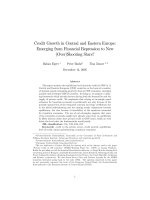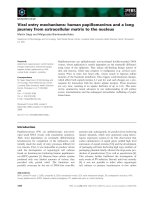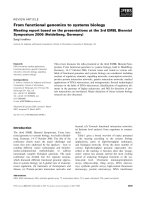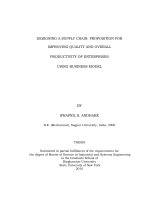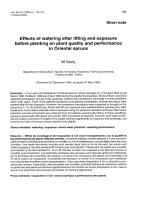improving quality and performance by transfroming from functional structure to process based structure at serenco company
Bạn đang xem bản rút gọn của tài liệu. Xem và tải ngay bản đầy đủ của tài liệu tại đây (560.62 KB, 62 trang )
HO CHI MINH CITY OPEN UNIVERSITY
UNIVERSITÉ LIBRE DE BRUXELLES
SOLVAY BRUSSELS SCHOOL OF
ECONOMICS & MANAGEMENT
MBQPM5
PHẠM VĂN THUẬN
IMPROVING QUALITY AND PERFORMANCE
BY TRANSFROMING FROM FUNCTIONAL
STRUCTURE TO PROCESS - BASED
STRUCTURE AT SERENCO COMPANY
MASTER FINAL PROJECT
MASTER IN BUSINESS QUALITY AND PERFORMANCE MANAGEMENT
Tutor: Jacques Martin
Ho Chi Minh City
(2016)
Statement of Authentication
I certified that this report is my own work and this work has not been presented
elsewhere for assessment. All materials and resources used in this report have
been properly acknowledged and referred.
Acknowledgements
I would like to thank Professor Jacques Martin and other professors form Solvay
Program for providing me good knowledge and materials about quality and
performance.
I would like to thank my classmates for their helps during class time and during my
doing the assignment.
I would also like to thank my colleagues at Serenco for their support me in getting
information and reports.
Academic tutor and practical tutor’s comments
Table of Contents
INTRODUCTION .................................................................................................................................... 1
1.
Company Overview ..................................................................................................................... 1
2.
Challenges for STECH ................................................................................................................ 4
3.
Project objectives and scopes...................................................................................................... 4
Chapter 1 ANALYSING THE CURRENT SITUATION OF STECH............................................... 6
1.
The organization structure analysis ........................................................................................... 6
2.
Process management analysis ..................................................................................................... 9
3.
Analysis the business results in quality and performance ..................................................... 10
Chapter 2 – ORGANIZATION TYPES AND THE CHOICE OF STECH..................................... 13
1.
Types of Organizational structure ........................................................................................... 13
2.
The choice for STech ................................................................................................................. 18
3.
The roadmap for transforming from functional to process - based structure ..................... 19
Chapter 3 – STRATEGY ANALYSIS, DEVELOPMENT AND PLANNING ............................... 20
1.
Strategy Analysis ....................................................................................................................... 20
2.
Strategy development ................................................................................................................ 24
2.1 Strategy statement ....................................................................................................................... 24
2.2 The strategy map ......................................................................................................................... 25
Strategy map comments ...................................................................................................................... 26
3.
Planning ...................................................................................................................................... 27
Chapter 4 – DESIGN CORE PROCESSES .................................................................................... 28
1.
Develop core processes .............................................................................................................. 28
2.
Process flow chart ...................................................................................................................... 34
Chapter 5 - RE-DESIGN THE ORGANISATIONAL STRUCTURE ............................................. 37
1.
Changing the organization structure ....................................................................................... 37
2.
Change in roles and responsibilities......................................................................................... 38
3.
Aligning processes and organizational structure .................................................................... 39
Chapter 6 – PROCESS IMPLEMENTATION PLAN ...................................................................... 41
1.
Implementation process ............................................................................................................ 41
2.
Development of process management tools ............................................................................. 41
Chapter 7 – MEASUREMENT & DASHBOARD ............................................................................ 43
1.
Performance management approach ....................................................................................... 43
2.
Process measurement ................................................................................................................ 44
3.
Performance summary report .................................................................................................. 51
CONCLUSIONS.................................................................................................................................... 52
1.
The application and usefulness of the project ......................................................................... 52
2.
What are the next steps ............................................................................................................. 52
List of Abbreviations
BSC
Balanced Scorecard
ERP
Enterprise Resource Planning
IT
Information Technology
SBU
Strategy Business Unit
KPI
Key Performance Indicator
QMS
Quality Management System
TQM
Total Quality Management
List of pictures
Figure 1: Current organization structure of Serenco ................................................................. 2
Figure 2: New organization structure of STech .......................................................................... 6
Figure 3: Current process structure ............................................................................................. 9
Figure 4: example of functional structure .................................................................................. 13
Figure 5: example of Divisional structure .................................................................................. 14
Figure 6: Example of matrix organization ................................................................................. 16
Figure 7: example of process-based organization ................................................................... 17
Figure 8: Transition model for Serenco ..................................................................................... 19
Figure 9 – Porter five forces model ............................................................................................ 23
Figure 10: The strategy map of sTech ....................................................................................... 25
Figure 11: General process mapping ........................................................................................ 32
Figure 12 – Detail Process mapping .......................................................................................... 33
Figure 13 - Sales process flow chart ......................................................................................... 34
Figure 14 - Purchasing process flow chart ............................................................................... 35
Figure 15 - Customer support process flow chart .................................................................... 36
Figure 16 - New organizational structure for sTech ................................................................ 37
Figure 17 - Processes - based structure ................................................................................... 39
Figure 18 - Performance management approach .................................................................... 43
Figure 19 - Process ID card for sales process ......................................................................... 44
Figure 20 - Process metric for sales process ........................................................................... 45
Figure 21 - Process ID card - Order fulfillment ......................................................................... 46
Figure 22 - Process metric for order fulfillment - on time delivery ......................................... 47
Figure 23 - Process metric for order fulfillment – Cost effective ............................................ 48
Figure 24 - Process ID card - Customer support ..................................................................... 49
Figure 25 - Process metric - Customer service process ......................................................... 50
List of tables
Table 1: List of products and services ......................................................................................... 3
Table 2: List of customer ............................................................................................................... 4
Table 3: Current management team ............................................................................................ 8
Table 4: Financial report .............................................................................................................. 11
Table 5: On time delivery report ................................................................................................. 11
Table 6 - Quaterly reports (Q1) ................................................................................................. 51
1
INTRODUCTION
1. Company Overview
1.1. Serenco Company
Serenco is a small company founded in 2004 and specialized in software
development and hardware supplying and IT services. The main market of
Serenco is local banking industry.
From the year of 2014, to adapt to the tough market, the company top
management had reorganized company structure and products. The company
has three main product categories which organized in three SBUs:
-
SBank: The key business unit of Serenco which providing banking software
and services for local market.
-
sTech: Focuses on IT Infrastructure services such as network installation,
Surveillance system, Alarm system,
-
sSoft: Focuses on providing software outsourcing service to foreign market
(US & Japan).
Each of the three SBUs have different products, different customer sectors and
have its own strategy to develop.
Serenco also have a Support Division to provide support services to all three
SBUs, including:
-
Accounting & financial service
-
Administrative and human resource
-
Planning and marketing
Serenco organization chart:
2
Executive Team
SBANK
SSOFT
STECH
SUPPORT
Banking
software &
service
Software
outsourcing
service
Hartware & IT
service
Marketing, sales
support and
Back office
Figure 1: Current organization structure of Serenco
1.2. Overview of sTech
STECH is Business Division of Serenco, was founded in 2007 and mainly
focused on IT trading and services. The main services of STECH are
designing and building IT infrastructure for its clients includes Networking,
Surveillance system and Alarm system. Almost 60% of its customers are
banks, the rest are construction companies and small enterprises. STECH has
about 30 suppliers including manufacturers like IBM, Cisco, Av-gad, etc
and
local distributors like FPT Distribution, ADG, The annual revenue of STECH is
about 40 billion VNĐ ( ~ 2 Million USD) and the Net Profit is about 5% of
revenues (100.000 USD)
Mission statement:
sTech’s mission is to help customers in building up a high quality and cost
effective IT infrastructures to increase their performance and service quality.
3
Business main objectives:
-
Delivery high quality service
-
Increase customer satisfaction
-
High profit (20% increase in profit every year)
Strategy
-
Improving processes and management to provide excellence service to
customers
Product and services
#
Products & Service
% of total revenues
I
Trading
65%
1
Server, Network devices, Security devices…
20%
2
Computer, laptop, office machines…
30%
3
POS EDC
5%
4
Software licenses
database…)
II
IT Services
35%
1
Networking design and installation
15%
2
Design & installation of Surveillance, Alarm
system…
15%
3
Maintenance services
5%
(windows,
antivirus,
Table 1: List of products and services
10%
4
Customers
#
Customer group
% of total revenues
1
Banking
60%
2
FDI enterprises
20%
3
SMEs
10%
4
Others
10%
Table 2: List of customer
2. Challenges for STECH
Like other IT companies in Vietnam, STech is also facing big challenges in
keeping the company survival and development. The challenges for sTech are:
-
Gross margin has gone downed in the past three years because of tough
competition and high operation cost.
-
STech is still based on traditional products and services which have low
valued added
-
The business environment is changing very fast and it requires sTech to be
more adaptable and flexible if it wants to survive.
3. Project objectives and scopes
3.1 Objectives
-
Adapting the company organization structure and management to help the
company to faster react to the rapidly changing in the market
-
Improve supply chain management to help the company become more
competitive advantages.
5
-
Improving the company performance to help the company become profit
again.
3.2 Scopes of the project
Reengineering and transforming an organization structure is not an easy work.
It needs a lot of time and resources to help the transformation success.
Therefore, in this project, we just focus on one SBU and on the first period of
the transforming journey.
-
Redesign the business processes of STech for Hardware Trading and IT
services
-
Implement the new processes and organizational structure to sTech
-
Develop measurement and performance reporting for monitoring sTech
performance
6
Chapter 1 ANALYSING THE CURRENT SITUATION OF
STECH
1. The organization structure analysis
STech is organized in functional structure with three departments: Sales,
Purchasing and Technical. The support activities are located in Support
division with three departments: Accounting, Administration & Human
resource, Marketing & Planning. The company structure supporting sTech
business as below:
EXECUTIVE BOARDS
STECH
SUPPORTS DIVISION
Sales Department
Accounting Department
Purchasing department
Admin & HR Department
Technical Department
Marketing & Planning
Figure 2: New organization structure of STech
7
Each department is managed and controlled by a departmental manager and they
report to director of sTech.
List of management team:
#
Position
I
STech’s department
1
Sales manager
Responsibilities
- Responsible for sale revenue
- Customer development
- Manage and develop sale team
- Control sale process
- Review contract before submit to director to
sign off
2
Purchasing manager
- Manage all suppliers
- Responsible for purchasing process
- Responsible for inventory and delivery
- Supplier development
3
Technical Manager
- Manage technical team
- Responsible
installation
for
technical
design
and
- Technical support
II
Support department
1
Chief Accountant
- Manage account department
- Responsible for the correction of accounting
booking
8
- Manage & control financial
- Manage receivable and payable
- Cash management
2
Administration
and - Administration management
Human
resource
- Human resource management (recruiting,
Manager
employee management, salary payment…)
- Planning for training, resource development
3
Marketing & planning - Develop marketing plan
Manager
- Implement marketing activities
- Planning and reporting for Serenco
Table 3: Current management team
Comments:
By investigating the organization structure and management, we can see many
issues in term of organization and management of sTech includes:
-
The organization structure is organized in functional structure where its
functions are grouped in department. Each department is managed and
controlled in by a department’s manager. Departmental managers nearly
have full power to their employees. This structure had help sTech develop
at the first time, but now it becomes an obstacle for the development of
sTech .
-
Some key functions of sTech (Marketing, financial…) are in Support
division and not controlled by sTech’s Director. It has caused many issues
in management and providing best service to customers.
-
Measurement and reporting are mainly based on department’s objectives
and they are all aligned with the objectives of sTech
9
2. Process management analysis
Current state of processes management of sTech:
Excecutive Board
sTech Director
Support Director
Sale
process
Purchasing
process
Technical
process
Accounting
process
Admin-HR
process
marketing
process
(Sale
Manager)
(Purchasing
Manager)
(Technical
Manager)
(Chief
Accountant)
(Sale
Manager)
(Sale
Manager)
Contact
customer
Call for
quotation
Planning
for install
Inventory
Accounting
Administrti
on
Planning
process
Prepare
Quotation
Select
Suppliers
Implement
ation
Payable
accounting
HR
process
Marketing
process
Make
contract
Make
contract
Acceptanc
e sign off
Receivable
accounting
Contract
closing
Goods
receive and
stocking
Technical
support
Customer
care
Delivery to
customers
Figure 3: Current process structure
10
Comments:
-
sTech’s business processes are separated in sub-processes that controlled
by different departments. Department managers will be responsible for the
quality and performance of their processes. This situation has caused
many issues because department managers have different objective and
they don’t look forward to the final results when products or services
delivered to customers.
-
There are huge barriers between department that prevent work flows and
information flows between departments. There are always a lot of
arguments and problems between departments when information transfers
from one department to another.
3. Analysis the business results in quality and performance
During the last three years, sTech have been geeting poor result both in
financial and service quality. These results showed on the company reports:
3.1 Financial performance report in last 3 years
Item/Quarter
2013
Revenue (Million VND)
Gross margin
2014
2015
33,000
37,000
40,000
Q1
6,000
7,000
7,000
Q2
7,000
7,000
8,000
Q3
9,000
10,000
10,000
Q4
11,000
12,000
15,000
11
Percentage (%)
16%
13%
12%
Value (million VND)
5,300
4,800
4,800
by Percentage
7%
5%
4%
By Value
2,300
1,900
1,600
Net profit
Table 4: Financial report
Comments:
-
The revenue keeps growing every year, but the growth is slowing down.
-
Although the revenue is increase, but the gross margin reduces, so the net
profit goes down.
3.2 On time delivery by product group
Years/Quarters
Total
On time
delivery
Delivery
Percentage
2013
210
155
74%
2014
250
190
76%
2015
275
210
76%
Q1
50
38
76%
Q2
70
52
74%
Q2
75
58
77%
Q4
80
62
78%
Table 5: On time delivery report
12
Comments:
-
The rate of on-time delivery has the same over the past three years despite
of the efforts of sTech’s management team in improving the processes
-
The low rate in on time delivery of IT services has caused not only
reduction the quality but also increasing the implementation cost especially
cost for engineers.
-
Improving the on time delivery will improve the service quality and improve
the business performance of sTech.
13
Chapter 2 – ORGANIZATION TYPES AND THE CHOICE
OF STECH
1.
Types of Organizational structure
The company structure has changed rapidly to adapt with the changing
business environment. There are five typical types of organization structure:
1.1 Functional structure
Functional organizational structures are the most common. A structure of this
type
groups
individuals
by
specific
functions
performed.
Common
departments such as human resources, accounting and purchasing are
organized by separating each of these areas and managing them
independently of the others.
Example of Functional structure:
CEO
Marketing
Manager
Sales
Manager
Purchasing
Manager
Technical
Manager
Accounting
Manager
Figure 4: example of functional structure
Advantages
Disadvantages
- Reinforces
- Short-term focus on - Business environment
specialized skills and
resources
routine tasks
- Business perspectives
Works best when
is
stable
predictable
and
14
- Reduces
duplication
of scarce resources
are narrow
- Communication
- Organization is small
other departments is
- Facilitates
communication within
and medium in size
with
- Quality is maintained
reduced
through routine tasks
department
1.2 Divisional structure
Divisions are mini-companies built around particular products or regions. A
car company could have one division for SUVs, one for luxury cars, and
another for economy vehicles, for example. Each division contains all the
functions necessary to handle business for that region or product line.
Because everyone in the division shares a common goal, such as boosting
sales for their products, there's more cross-function cooperation. The
downside is that every division duplicates the same functions - sales,
marketing and manufacturing - which is often wasteful.
CEO
Division
product X
Division
Product Y
Division
Product Z
Maketing Dept.
Maketing Dept.
Maketing Dept.
Sales Dept.
Sales Dept.
Sales Dept.
Technical Dept.
Technical Dept.
Technical Dept.
Figure 5: example of Divisional structure
15
Advantages
- Key
Disadvantages
independencies - There
is
Works best when
heavy - The organization is
and resources within
duplication
the
resources, skills and
division
are
of
coordinated toward an
expertise
overall outcome
division has its own
functions
as
each
very large in size
- Business
environment
is
dynamic and always
in flux
- Multiple products and
customer types exist
1.3 Matrix structure
The matrix structure is often overlaid on top of a company's functional
structure to tackle projects that involve multiple departments. Project
managers recruit staff for their teams from different departments so that all
the necessary functions work on it together. This offers companies flexibility
and a better use of resources than a purely functional model. The downside
is that authority and the chain of command become more confused, as team
members answer to both the project manager and their department
supervisor.
16
Figure 6: Example of matrix organization
Advantages
Disadvantages
- Interdependencies
- Difficult
and
between
departments
are
managed well
- Skill
diversification
to
Works best when
manage - The organization is very
control
the
coordination
- Business environment is
- Employees may face
unclear
roles
and training across
inconsistent
functions is easier
demands
large
and
job
uncertain
and
unpredictable
- High
level
of
technological
interdependency across
functions exist
- The
goals is
specialization
innovation
product
and
